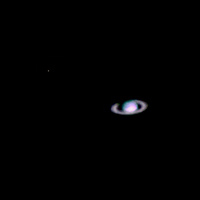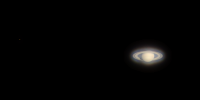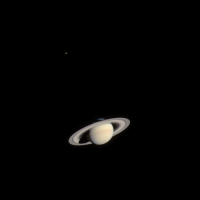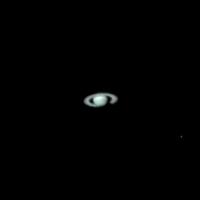Printable Version of Topic
Click here to view this topic in its original format
Unmanned Spaceflight.com _ Saturn _ Saturn from Galileo
Posted by: Paolo Nov 24 2007, 10:41 AM
I don't know whether this has ever been reported in the forum.
During E18, in December 1998, Galileo took some camera calibration pictures of Saturn, Uranus and Neptune. This is one of the clearest views of Saturn (untreated "raw" image). However, I cannot make out Uranus and Neptune from their raw image. I think they are somewhere between the cosmic rays and radiation blemishes...
Posted by: tedstryk Nov 24 2007, 01:51 PM
We discussed it at some point. I made a false color version of it.
Posted by: ugordan Nov 24 2007, 01:56 PM
Didn't you say that one's from C22? http://www.unmannedspaceflight.com/index.php?s=&showtopic=909&view=findpost&p=13606
Is there more than one calibration observation of Saturn?
Posted by: Paolo Nov 24 2007, 02:47 PM
Is there more than one calibration observation of Saturn?
I checked and in fact there are others from C22. http://pdsimg.jpl.nasa.gov/data/go-j_jsa-ssi-2-redr-v1.0/go_0021/e18/raw_cal/c047742/3126r.lbl of my image, from E18
Posted by: Paolo Nov 24 2007, 04:12 PM
It turns out Uranus was not difficult to find in E18 pictures, because they were taken while the camera was slewing.
I still can't find Neptune however
Posted by: tedstryk Nov 24 2007, 04:40 PM
Is there more than one calibration observation of Saturn?
Yes. There are two sets. The C22 set is better though.
Posted by: ugordan Nov 24 2007, 10:26 PM
Since we're at the topic of unremarkable Saturn sets, here's one showing the state of Cassini's narrow-angle camera after the Jupiter encounter:
Gamma-correct display version. Titan is the speck at left and appears much more red because the haze scattered blue light strongly - hence a mostly bluish halo around Saturn. This is AFAIK the first ever image of Cassini's ultimate target, taken on July 13th, 2001. The phase angle is similar to what can be observed from Earth.
As a comparison, an image taken 15 months later showing the haze is pretty much history:
Posted by: volcanopele Nov 24 2007, 10:28 PM
Remind me at the beginning of January to post some of the Cassini images of Jupiter from February of this year.
Posted by: ugordan Nov 24 2007, 10:30 PM
Why not now? Hasn't a RGB set already been released - http://ciclops.org/view.php?id=2582?
When you compare the blue channel images from Feb 2007 and May 2004, it's amazing how much change is visible in Jupiter's belts and zones even at such low resolution:

At the left is the view of Jupiter at the time of New Horizons' flyby, while the 2004 image is more typical of what Cassini saw when it flied by the planet.
Posted by: volcanopele Nov 24 2007, 10:34 PM
Oh, you're right:
http://photojournal.jpl.nasa.gov/catalog/PIA08899
sorry, forgot about that. Though I will note that the smudge to the left of Jupiter is Ganymede and Europa. The smudge to the right of Jupiter is Io.
Posted by: tedstryk Nov 25 2007, 02:27 AM
I re-did the image. The old version was done pre-crash, so I have no idea what I did before. The color is based on three near infrared wavelengths (which is all that Galileo took).
Posted by: Paolo Nov 25 2007, 09:21 AM
That's definitely better than E18, in fact
Posted by: ugordan Dec 24 2007, 12:30 AM
Here's the Cassini Jupiter 2007 set revisited:
http://farm3.static.flickr.com/2216/2133143185_d3b6624b79_o.png
Posted by: rlorenz Dec 24 2007, 02:51 AM
Can you make Titan out ?
I remember seeing these when they were acquired (looking over the shoulder of
some Galileo people at LPL) but before released on PDS. I remember thinking they
might be interesting insofar as those would be the highest-phase-angle Near-IR
images ever acquired of Titan (at the time). Now eclipsed, so to speak, by Cassini,
although even then the photometry might be interesting re seasonal change....
Posted by: tedstryk Dec 25 2007, 07:09 PM
I brought in in from some of the severely overexposed images. I may have used the set from the other Saturn- imaging orbit. I am in London now, so I am working completely from my jetlagged memory. I will check my notes when I get home.
Posted by: elakdawalla Dec 26 2007, 12:32 AM
See for yourself...all the images and labels for the E18 can be found http://pdsimg.jpl.nasa.gov/data/go-j_jsa-ssi-2-redr-v1.0/go_0021/e18/raw_cal/c047742/; and here's a http://space.jpl.nasa.gov/cgi-bin/wspace?tbody=699&vbody=599&month=12&day=10&year=1998&hour=15&minute=55&rfov=2&fovmul=-1&bfov=5&porbs=1&showsc=1 that shows you approximately where stuff should be during the observation, which included ten images from 15:39 to 16:28 UT on December 10, 1998. There were two pointed at Titan (IR-7560, IR-7270), four at Saturn (2@IR-7560, 2@IR-7270), two at Uranus (2@IR-7560), and two at Neptune (IR-7560, IR-7270).
There was also a set taken on C22, August 13, 1999. http://space.jpl.nasa.gov/cgi-bin/wspace?tbody=699&vbody=599&month=12&day=10&year=1999&hour=18&minute=30&rfov=2&fovmul=-1&bfov=5&porbs=1&showsc=1. Twenty-three http://pdsimg.jpl.nasa.gov/data/go-j_jsa-ssi-2-redr-v1.0/go_0021/c22/raw_cal/c051243/ were taken in three different IR filters (IR-7560, IR-7270, and IR-8890), and then six http://pdsimg.jpl.nasa.gov/data/go-j_jsa-ssi-2-redr-v1.0/go_0021/c22/raw_cal/c051247/ beginning around 18:30 of the same day in filters (3@IR-7560, 3@IR-7270).
--Emily
Powered by Invision Power Board (http://www.invisionboard.com)
© Invision Power Services (http://www.invisionpower.com)



